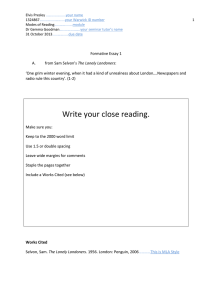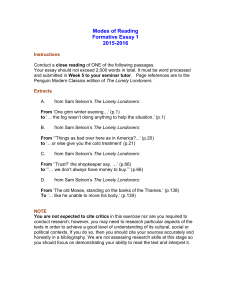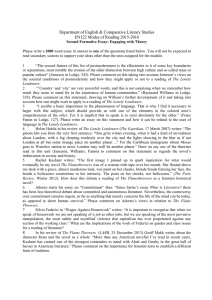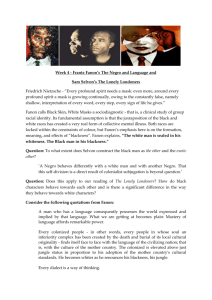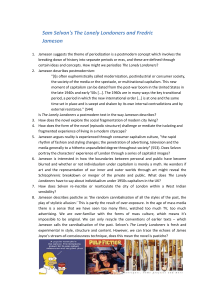Department of English and Comparative Literary Studies
advertisement
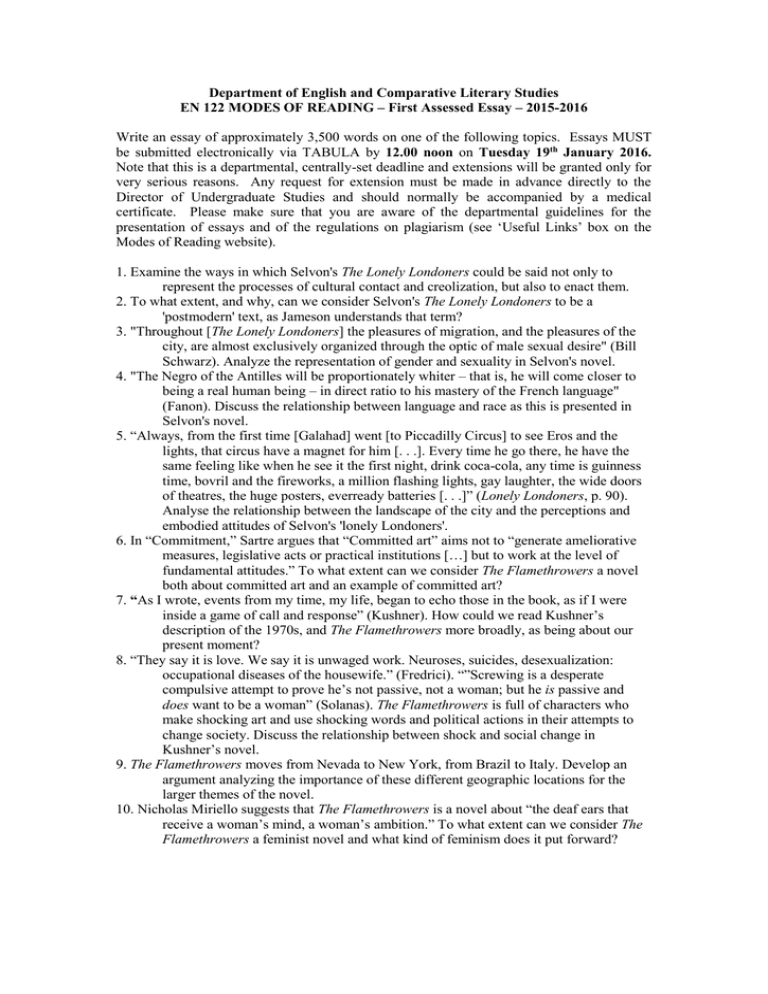
Department of English and Comparative Literary Studies EN 122 MODES OF READING – First Assessed Essay – 2015-2016 Write an essay of approximately 3,500 words on one of the following topics. Essays MUST be submitted electronically via TABULA by 12.00 noon on Tuesday 19th January 2016. Note that this is a departmental, centrally-set deadline and extensions will be granted only for very serious reasons. Any request for extension must be made in advance directly to the Director of Undergraduate Studies and should normally be accompanied by a medical certificate. Please make sure that you are aware of the departmental guidelines for the presentation of essays and of the regulations on plagiarism (see ‘Useful Links’ box on the Modes of Reading website). 1. Examine the ways in which Selvon's The Lonely Londoners could be said not only to represent the processes of cultural contact and creolization, but also to enact them. 2. To what extent, and why, can we consider Selvon's The Lonely Londoners to be a 'postmodern' text, as Jameson understands that term? 3. "Throughout [The Lonely Londoners] the pleasures of migration, and the pleasures of the city, are almost exclusively organized through the optic of male sexual desire" (Bill Schwarz). Analyze the representation of gender and sexuality in Selvon's novel. 4. "The Negro of the Antilles will be proportionately whiter – that is, he will come closer to being a real human being – in direct ratio to his mastery of the French language" (Fanon). Discuss the relationship between language and race as this is presented in Selvon's novel. 5. “Always, from the first time [Galahad] went [to Piccadilly Circus] to see Eros and the lights, that circus have a magnet for him [. . .]. Every time he go there, he have the same feeling like when he see it the first night, drink coca-cola, any time is guinness time, bovril and the fireworks, a million flashing lights, gay laughter, the wide doors of theatres, the huge posters, everready batteries [. . .]” (Lonely Londoners, p. 90). Analyse the relationship between the landscape of the city and the perceptions and embodied attitudes of Selvon's 'lonely Londoners'. 6. In “Commitment,” Sartre argues that “Committed art” aims not to “generate ameliorative measures, legislative acts or practical institutions […] but to work at the level of fundamental attitudes.” To what extent can we consider The Flamethrowers a novel both about committed art and an example of committed art? 7. “As I wrote, events from my time, my life, began to echo those in the book, as if I were inside a game of call and response” (Kushner). How could we read Kushner’s description of the 1970s, and The Flamethrowers more broadly, as being about our present moment? 8. “They say it is love. We say it is unwaged work. Neuroses, suicides, desexualization: occupational diseases of the housewife.” (Fredrici). “”Screwing is a desperate compulsive attempt to prove he’s not passive, not a woman; but he is passive and does want to be a woman” (Solanas). The Flamethrowers is full of characters who make shocking art and use shocking words and political actions in their attempts to change society. Discuss the relationship between shock and social change in Kushner’s novel. 9. The Flamethrowers moves from Nevada to New York, from Brazil to Italy. Develop an argument analyzing the importance of these different geographic locations for the larger themes of the novel. 10. Nicholas Miriello suggests that The Flamethrowers is a novel about “the deaf ears that receive a woman’s mind, a woman’s ambition.” To what extent can we consider The Flamethrowers a feminist novel and what kind of feminism does it put forward?
